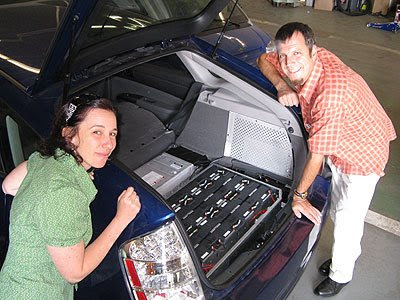First things first: how do you get your Prius converted into a plug-in hybrid? I met with Paul Guzyk and Carol Lipof of 3Prong Power to find out what they are up to. Carol takes me to the work bay.

"Most people don't really want to know about the workings inside their car," Paul tells me. "But, here's where we've put 20 lead acid batteries into the wheel well. It adds 300 pounds but not much of a change to the car's handling. We install some stiffer springs and that takes care of the weight.
"You still have the same trunk space. And the whole battery rack is on hydraulics so you can easily access the spare tire if you need to.
"Want to go for a drive?"
Um, yes.
Out on the road, Paul turns to me. "We're going to go into 'Stealth' mode."
"This is my favorite part," says Carol.

Paul touches the Prius' in-dash screen and accesses the new mode. "The Prius is a closed architecture system, but all the subsystems communicate via Bluetooth. So we can 'spoof' the computer and introduce a new operating mode. We've left all the original Prius systems in place. We don't take anything out, we just add to it."
That and some legislation is why the Toyota warranty is not voided by the mods that 3Prong installs.
"So this sort of DOS looking screen shows that we are running entirely on batteries. Our lead-acids are used to keep the Prius' NiMH batteries topped off, and the gasoline engine doesn't start. We can go up to 52 miles per hour and about 10 miles in all electric mode. We can sit in traffic, running the air conditioning, the brakes, the power steering, all without gas. The Prius is just bulletproof. It has a great reputation. We just leverage off that, and you get a fully crash-tested, modern car with all the highway safety features right now, instead of waiting for a Toyota or Chevy concept car."
Ten miles is really about as far as most people drive when doing their around-town errands. I imagine parents who might be nervous about strapping a child safety seat into a neighborhood EV would be quite happy driving their children around in an all-electric Prius. The gasoline back-up is still there, of course, for those longer trips. How easy is it to charge?
"We install a plug through the rear bumper. You just plug it in to a normal wall socket," Carol explains.
"This isn't 'the' answer," says Carol. "There are many solutions, rather than a single magic bullet. What this does is gives us more choices. There are lots of sources to generate electricity and power an electric car, rather than being reliant on one source, petroleum, that causes politcal strife. Instead of being at the mercy of others, we get more options."
One of those options is solar power. "This Prius is owned by a customer who already has solar panels on his house. He's generating so much extra energy... and he wants to use it, since PG&E doesn't actually pay you for generating more than you use. So he'll be driving his first 10 miles each day essentially for free," says Paul.
I got a two-fer! On-site is a hydrogen fuel cell! We peeked inside it. Six large tanks deliver hydrogen through a platinum-laced proton-exchange-membrane, generating (wait for it...!) electricity!
Uh..., don't we get electricity a lot easier from the grid? How much cost and effort is it going to be to build the infrastructure for a hydrogen economy?
"Fuel cells are cool," Pauls tells me. "But they are expensive. How do you generate, distribute and store the hydrogen? It's cool, but not very cost effective.
"The existing infrastructure of the electric grid has so much over-capacity at night, that it could support charging 100 million plug-in cars. Balanced power load is important to power companies. It's hard on the equipment to power it down and power it back up again each night and day. They'd much rather just leave it running. Plug-in hybrids are the solution for the next five to ten years. The energy infrastructure is in place now."
Sounds good to me. I'm a much bigger fan of electrons than protons, for energy and power. Protons are heavy. We aren't very good at moving them. CERN just started operating a giant machine built solely for the task of transporting hydrogen nuclei in a 17-mile circle at a cost of billions. Well, ok, the LHC will also detect the Higgs boson and could also create a world-eating mini-black hole, but the point is that electrons are far easier to generate and store. You can do it at home, with a solar-powered battery charger.
 3Prong Power is currently taking orders to make your Prius into a plug-in. The procedure is fairly priced at under $7000. For comparison, a non-crash-rated NEV costs between $3000 and $10,000. 3Prong Power shares a showroom with Berkeley's Green Motors, at 1500 San Pablo Avenue. If you drive a Prius, or can buy one as it comes off a rental fleet, I strongly suggest you consider getting this upgrade.
3Prong Power is currently taking orders to make your Prius into a plug-in. The procedure is fairly priced at under $7000. For comparison, a non-crash-rated NEV costs between $3000 and $10,000. 3Prong Power shares a showroom with Berkeley's Green Motors, at 1500 San Pablo Avenue. If you drive a Prius, or can buy one as it comes off a rental fleet, I strongly suggest you consider getting this upgrade.


No comments:
Post a Comment